Ifi Audio has been putting out awesome products for affordable prices for some time. One of the latest product releases is The Go Bar, a $329.00 DAC/AMP that just plugs into any USB audio device or smartphone and allows you to connect nearly any type of headphone you can imagine (Sorry Stax folks). With both a TRS and TRRRS (unbalanced and balanced respectively) output jack you can get the most out of what you have. The balanced connection is 4.4mm so if you have a 2.5mm cable you will need an adapter or a different cable, depending don’t the route you want to take. The Go Bar comes with adapters to fit USB C, USB A, and Lightning so it should git just about any modern device with USB audio out. The Go bar also does not require separate power, just plug in and listen. The Go Bar has enough power to drive some of the most demanding headphones out there to comfortable listening levels, but does it have what it takes to be your next piece of mobile Hifi Kit? Let’s jump in and find out.

Set up
The Go Bar does not take much in the way of setup out of the box. All you have to do is pick your desired cable to connect to the device you want to listen to and you’re off to the races. There are however some settings that you can explore to enhance your experience depending on your tastes. Like many of iFi’s products, you have some digital filters as well as X-Space and X-Bass. These can be turned on and off using the three side buttons in different button presses. This can be a little tedious, though with ultra-portability you have to make concessions when it comes to the user interface. Just like it is easier to type on a laptop than on a phone it is much harder to put a laptop in your pocket. I wouldn’t say it is hard to get to the settings just not as easy as on say the Gryphon which also has a screen, and is like 6 times larger. Once you have found the settings you like you are all set, nothing left to do but listen to your favorite music.
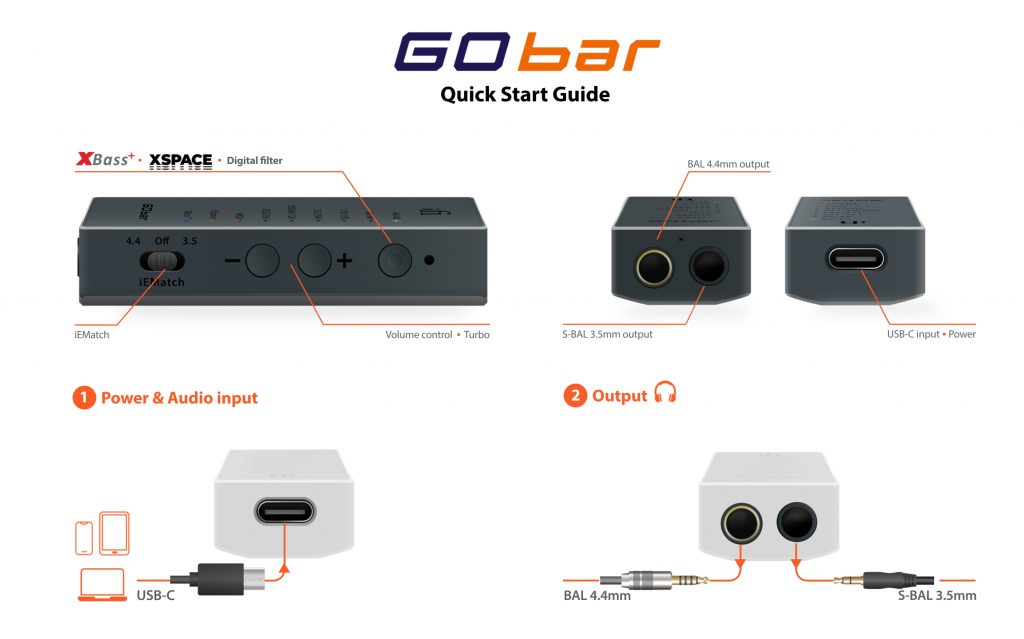
Features
The Go Bar has a fairly good list of features for its size and price. You get two output options, filters, EQ presets, and all of the Hi-Res processing you could want. With Native DSD256 and MQA unfolding, you can get the most out of your favorite streaming service. If you play ripped CD files locally you won’t be missing out either with support for PCM up to 384kHz. I played a variety of file types through the Go Bar and played with the filters and EQ settings, I have to say it’s certainly a feature-rich device.
While you will not be giving up sound quality, something you will be giving up in the small package is an internal battery, this may be an issue or feature depending on your perspective. I personally hate having to remember to charge a bunch of devices for the day and would certainly forget to charge the Go Bar. Now if you are using an older mobile device that already has a low battery life, the Go Bar may not be the best option for you, something with its own power such as the Go Blu, or Hip Dac. It is hard to say how much extra battery my phone used when using the Go Bar as I don’t really have an average use day and so many factors play into phone battery life.
Sound
The Go Bar can be as neutral or colored as you want to make it. When I listened with the Meze 99 Classics which are warm headphones the X-Bass was a little much for me, but with my open-back Beyerdynamic DT990 Pro’s the X-Bass helped richen up their thinner bottom end. Now if you are a bass head and have bassy headphones you can certainly turn on the X Bass and get even more. While many audiophiles pursue neutral flat sound, that doesn’t mean everyone does. I like that iFi gives me options to tailor the sound to my preference. The X-Space feature opens up the sound a bit, giving more space and airiness to your music. With closed-back headphones, it can help with getting the sound out of your head a bit and widen the stage. I also played with the filters available and found at least while listening on the Meze 99s I like the GTO filter the best. Each one alters the sound slightly to help you find the right sound to match your other equipment and personal taste. When I listened with Meze 99 Classics, which are warmer bassier headphones I tuned off the X-Bass as it was a little overpowering. I used the Meze with both the 4.4mm Balanced Cable and the 3.5mm standard cable. When you have a balanced circuit taking advantage offers a little more power, better detail, and channel separation. The Go Bar has fully separate balanced Left and Right channel output so it’s not just separating at the end of the line for the output jack.
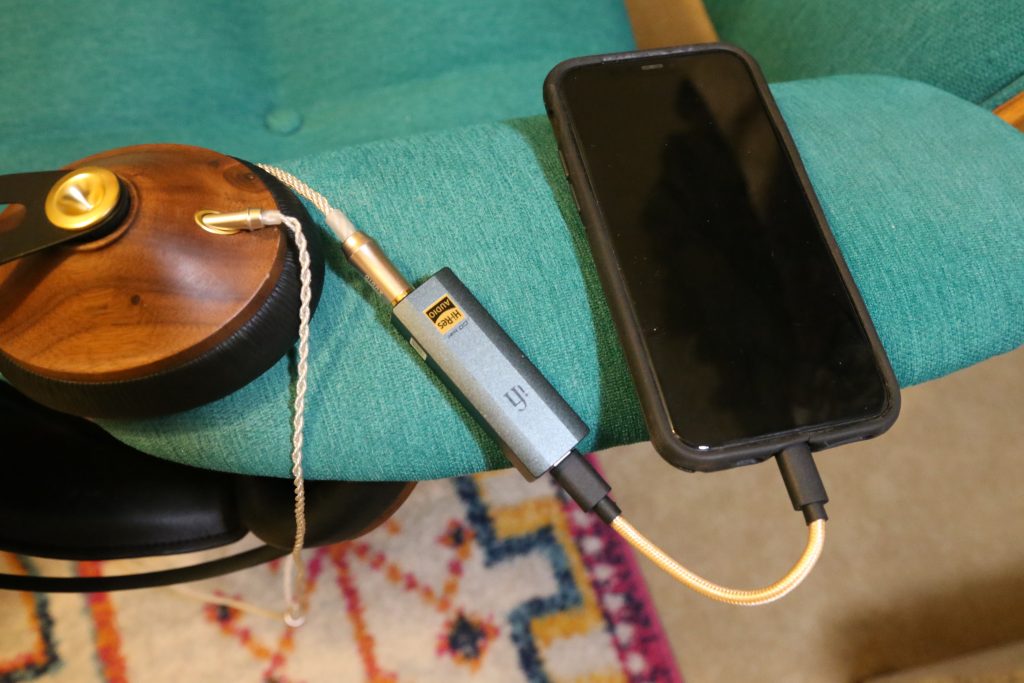
I listened to both ALAC files I put onto my iPhone as well as Spotify Premium. I listened per usual to a variety of music. The ALAC files were Taylor Swift – “Wildest Dreams”, Tribe Society – “Pain Told Love”, and Headphone Activist – “Northend Nightlife”, ALAC is the Apple equivalent to FLAC, a lossless compressed file.
iPhone Comparison
Listening to Wildest Dreams through the Go Bar brought out the sort of whimsical dreamy feeling that the song gives off. With a better resolution of the whispy transient background, you get transported away and create a mental picture of the scene Taylor is painting with her words. Straight out of an iPhone its a more muted and you lose some of the layerings of instruments as there are many faint effects and instruments woven throughout the song.
When I switch gears to the Indie synth-pop group Tribe Society, I listened to “Pain Told Love” a very dense song. Layer after layer of sound, from the lightest background percussion to the up-front synths and vocals. They create an excellent feeling of space in the recording as it is a duet with singing almost opposed, with echoes and reverb creating the sound of signing in a large hall or cathedral. The Go Bar brings everything the song has to offer without discrimination. You get everything, the emotion, the power, and the space of the song.
I love to listen to Northend Nightlife, Headphone Activist creates amazing music. Northend Nightlife is a tough song, it has such dynamic range and such powerful bass I have had amps drop volume drastically during the bassier parts. Often you get muted highs and mids when you don’t have the power reserve and dampening factor to keep the woofers fed and in check. Listening straight out of the iPhone you can hear the drops in the mids and highs, but the Go Bar has plenty of power to keep the whole frequency range playing how it should be.
MacBook Pro Comparisons
I listened through the same songs and overall have a similar experience. The Macbook has a decent audio section and since its real estate is at less of a premium than an iPhone it makes sense that they can do more in terms of power and sound quality. However there is no balanced support, it doesn’t have as much power as the Go Bar, this was evident listening to my Beyerdynamic DT990s. At max volume it was okay, but you really never want to have to be at the max output, there is no headroom left and when listening to Northend Nightlife the bass was muddy, and the top and mid suffered anytime it hit. That simply was not the case when listening through the Go Bar, to get the same volume I was about 2/3 of the way up on the go bar, leaving space for heavy draws. Comparing the easy-to-drive Meze 99 Classics is a different tale, as the MacBook has no issue driving them the only difference becomes sound quality. When using standard 3.5mm cable to keep things fair the difference is not going to blow you away, while detail and staging are better on the Go Bar it won’t necessarily knock your socks off. However when we cheat and get to use the balanced output the differences in detail, sound stage, and imaging become more apparent. I do not know what Apple uses for their DAC in the MacBook as this is not an advertised chip, Apple has in Ipods used Wolfson’s so it possible that they are outsourcing quality DACs for them but there is not much info out there on this subject. Later models have been found to Use Texas Instruments amplification and Cirrus DACs.

Pros
- Easy to use
- no need to charge
- better sound than phones’ built-in audio
- small
- lightweight
- solid construction
- Wide range of format support
Cons
- no battery so will use device power
- the user interface is super basic and tedious
- not the most powerful amp
- not the best button feel

Manufacturer Specs
| Input | USB C | |
| Formats | PCM DSD DXD MQA | 44.1/48/88.2/96/176.4/192/352.8/384kHz 2.8/3.1/5.6/6.1/11.3/12.3MHz 352.8/384kHz Full Decoder |
| DAC | Bit-Perfect DSD & DXD DAC by Cirrus Logic | |
| Headphone Output | BAL 4.4mm/UnBAL 3.5mm | |
| Power Output | Balanced UnBAL | 475mW@32Ω; 7.2V@600Ω 300mW@32Ω; 3.8V@600Ω |
| Output Impedance | <1Ω (BAL/UnBAL)* | |
| SNR | 132dBA / 108dBA (BAL/UnBAL) | |
| DNR | 109dB(A) / 108dB(A) (BAL/UnBAL | |
| THD + N | Balanced UnBAL | <0.002% (6.5mW/2.0V @ 600Ω) <0.09% (100mW/1.27V @ 16Ω) |
| Frequency Response | 20Hz – 45kHz (-3dB) | |
| Power Consumption | <4W max. | |
| Dimensions | 65 x 22 x 13.2 mm (2.6″ x 0.9″ x 0.5”) | |
| Weight | 28.5g (1.0 oz) | |
| Warranty period | 12 months |

Testing Gear:
- Meze 99 Classic
- Beyerdynamic DT990 Pro 250ohm
- MacBook Pro (2015)
- iPhone Pro 11
Conclusion
The Go Bar is a great device for the Audiophile on the go. You can plug it into just about any modern device and get better power and sound quality. The nice thing is if you use your phone as a source at home as well you are going to improve your home sound as well. I don’t think this is the product I would buy primarily for at-home use as both iFi and other companies offer better options for non-mobile applications. Though for someone who listens to headphones at the office or on the commute to work it’s a great small device. Beyond sound quality improvements, you also expand your options for headphones, gaining a balanced output as well as support for harder-to-drive higher ohm headphones. While it may seem as though you are giving up some convenience, I think it’s really not an issue as with just about any mobile phone you have to use some type of dongle now s headphone jacks are a thing of the past. While it is bulkier than the included iPhone dongle you are getting something for the size sacrifice. For me, the biggest drawback was getting the settings I wanted and the volume control. I had to reference the manual a couple of times to get into the menu I wanted and to see what the LED color indicated for the filters. Another small complaint I have is the text color, in lower light, it is nearly impossible to see, higher contrast would go a long way for usability. Certainly, this is not a huge issue as you will probably memorize this over time, however, I am a big fan of volume dials or knobs, like what is found on the Go Blu from iFi. I am a fan however of the included accessories as the cables and USB adapter covers pretty much any use case other than mini USB which is not super common now, and adapters are available. The small case has a fairly premium feel and will keep the Go Bar from getting scratched or marred on the go, especially if it is in a pocket with keys. Overall I think it offers better value than the similarly priced Audioquest Cobalt, you get various listening options as well as a better assortment of included connectivity for the same price.



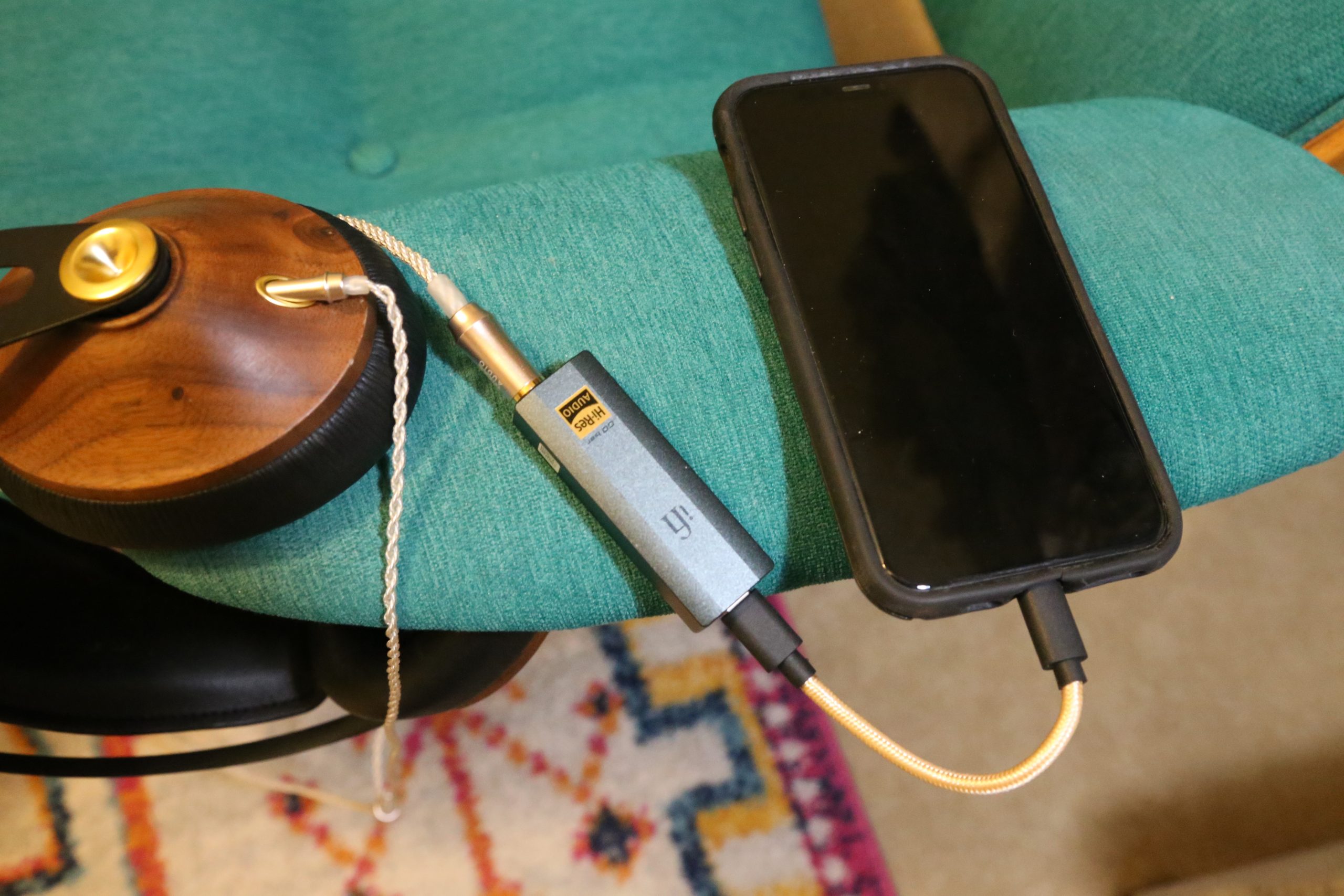
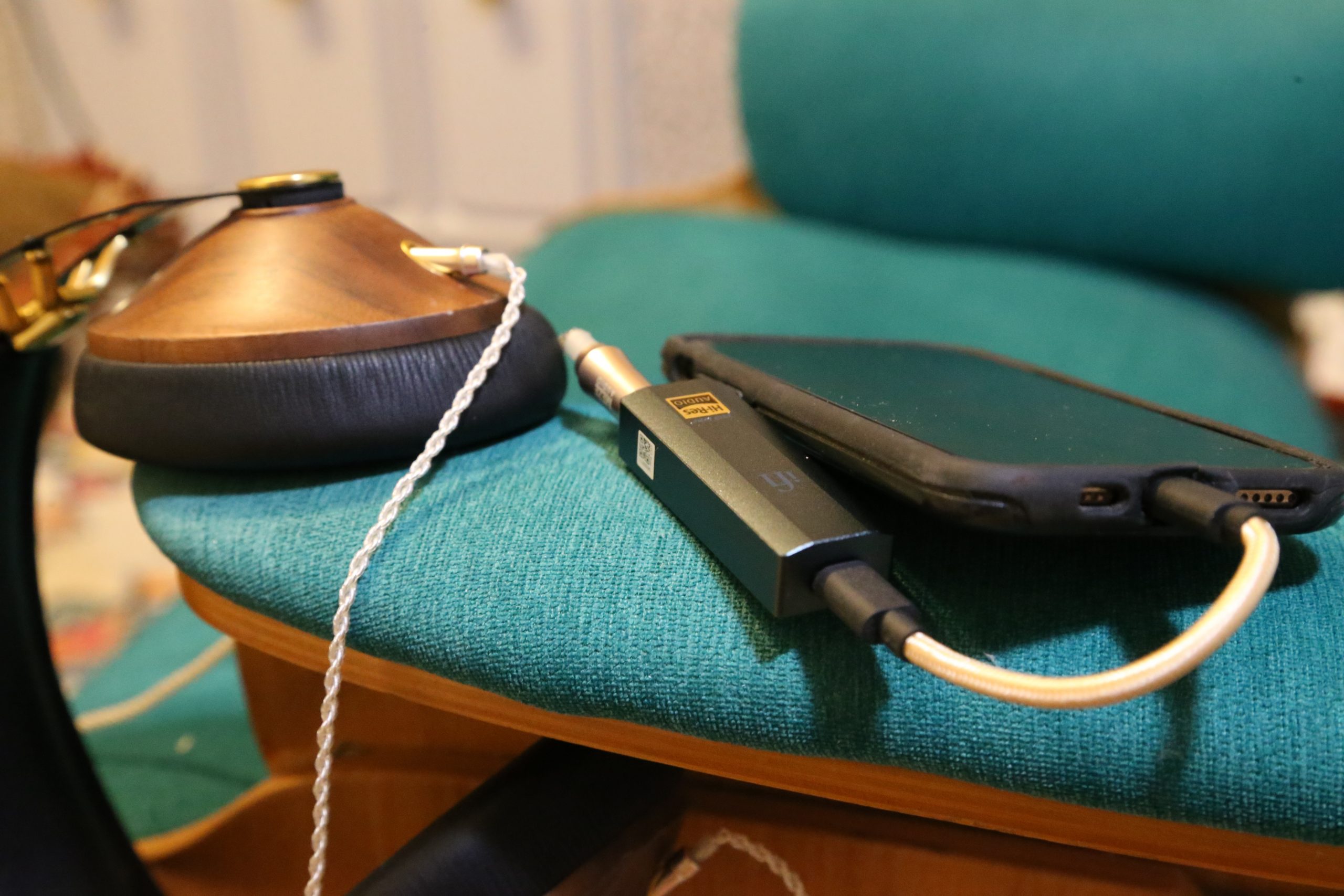
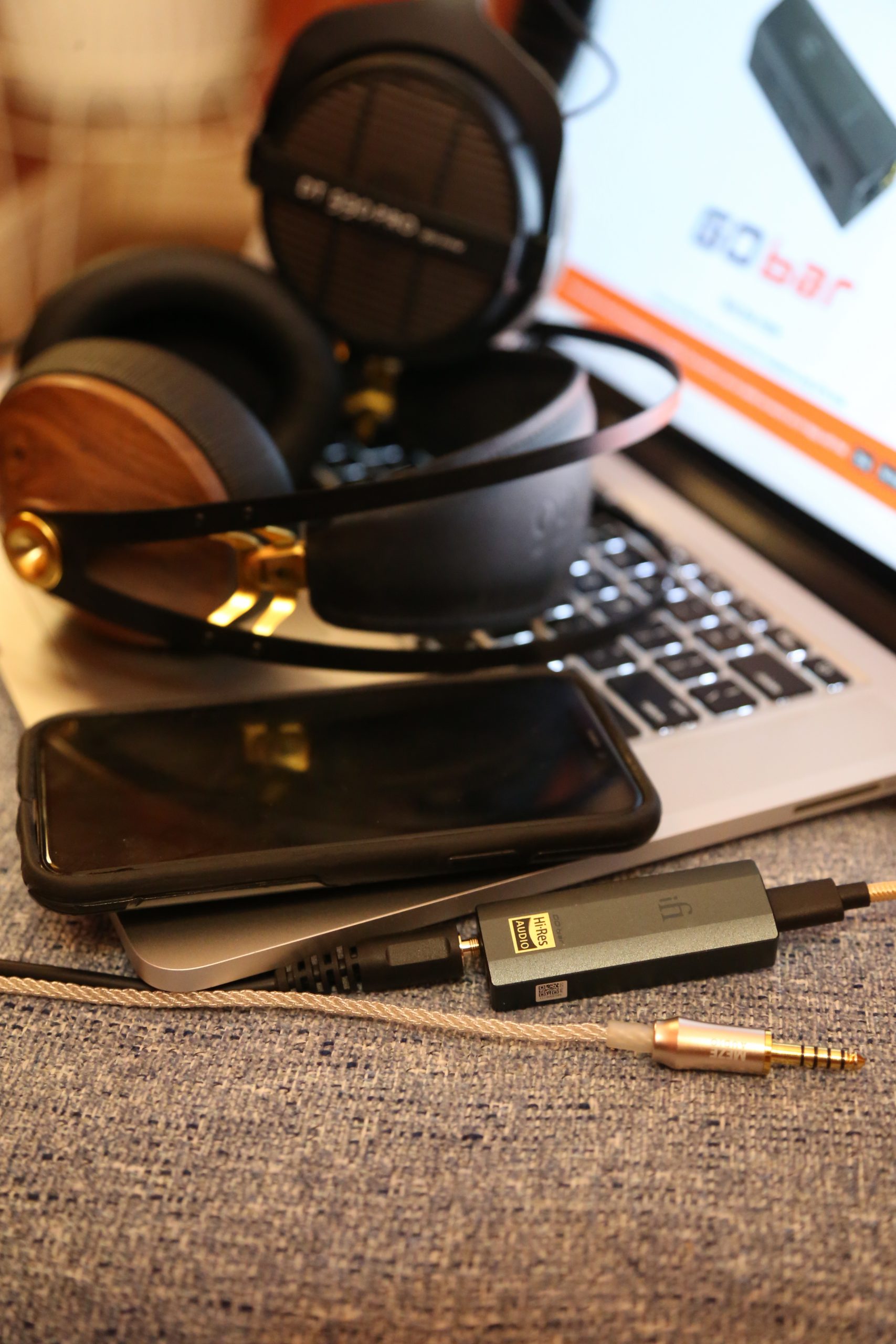
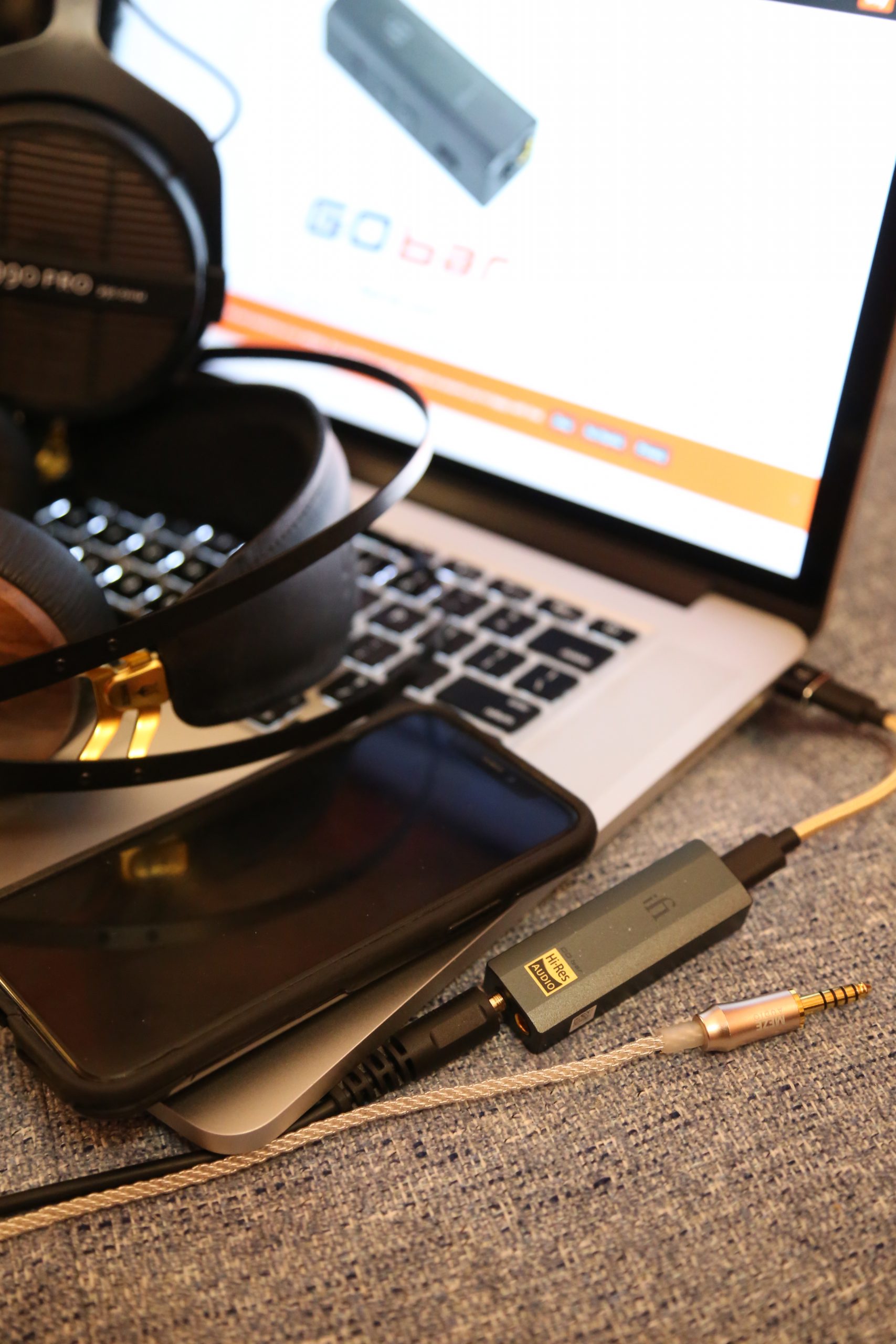
Disclaimer:
iFi Audio supplied Hifi Chicken with a review unit of the Go Bar, iFi Audio, nor any affiliate paid in part or full in exchange for this review.
